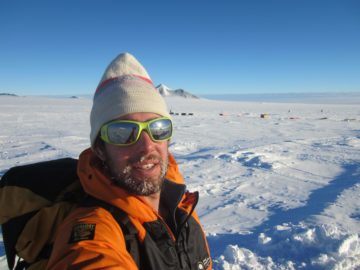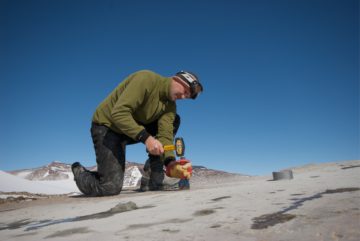ANTARCTIC BLOG: Extreme Geology #8
27 January, 2016 Marie byrd Land
Reflections from the ANiSEED team in Marie Byrd Land
Field Guide Al Docherty recounts his most memorable day of the field season so far:
“7am the alarm goes off. I look over and Steve doesn’t move much. I muster the energy to roll over and squirt some meths on the primus stove. Get it lit then I can rest my eyes a little more while the snow I strategically placed in the pan the night before melts.
We are off to Eisberg Head today, our most northerly and remote-feeling site: a small crumbling headland of basalt perched on the edge of the Crosson Ice Shelf. “We’re off to the seaside on us holidays!” I exclaim. The usual morning race between tents to be ready ensues. By 9am I’m leading a 100-metre line of skidoos and sledges across the glacier towards Eisberg, hoping the mid-level clouds that have built won’t obscure the sun and lower the contrast. We need it to stay bright so we can spot the crevasses.
We power up the snow slopes to a wind-scoop below the rock ridge. We know there will be a cracking view from the top over the heavily crevassed ice shelf. “Absolute stunner!” I cry as I get the first glimpse. “Crikey” exclaims Cheese [Iain] as the four of us assemble on the crest. The ice shelf is wrapping around the headland, deforming into colossal ramparts and chasms resembling a twisted, tortured fabric. Roped up we scramble east along the ridge hunting for erratics or some other evidence of the glacier overtopping this feature. There is nothing to be found on this choice pile. We reach a high point and stop to take photos and plan our next move.
Lower rock outcrops about 3km to the east (off the edge of the map and therefore the known universe) may offer some potential. Me and Cheese harness up to pulks and we all ski across to the outcrops. A desolate and remote place, it offers new views over mountains to the east. “Cool cool,” Cheese remarks – his favourite tagline.
We don’t find anything that excites Steve or Jo so we return to the skidoos, gliding slightly downhill back into the familiarity of our own basin. We decide to check the north side of Eisberg where there appears to be some glacial drift: a sight that never fails to get Steve’s pulse racing. We skidoo round to the grounding line at the base of Eisberg. This is where the floating ice shelf meets the rock of the mainland.
Cathedrals and tower blocks of ice form the view to our left as we walk in for the third time today. The crumbling vertical scree on our right is melting in the evening sun producing a constant gushing sound of heavy snow, water and rocks. We reach the drift and realise it is actually rockfall from the cliffs sat on top of the ice shelf. Not much use to us. However Cheese and Jo set up the Trimble to get an altitude measurement from the grounding line. Me and Steve set up our drone (“Jerome”) for a flight.
The evening sun is voracious still. It’s one of the reasons I like coming to Antarctica. You can just carry on into the night without fear of benightment. I often get exasperated at home, especially in winter, with the shortness of the days.
We call Rothera for our daily radio sched, pack up and head back to the skidoos. We hammer across the glacier back to the familiarity of the tents, some quick scram and bed. Ready to hit the repeat button tomorrow.”

Steve Roberts describes his favourite day:
“For me, it’s difficult to choose between three days which stand out during the course of the trip: firstly, the trip across from our Kay Peak Camp to Eisberg Head with the evening trip down to the ice shelf edge was varied and exciting (see Al’s post above); secondly, moving camp from Kay Peak back round to our first camp up by Mount Murphy up the Turtle Rock ramp was a challenging task, which, thanks to some excellent logistical arrangements from Cheese and Al, all worked perfectly to plan. Both were memorable, but I have chosen the day we flew “Jerome” (our small drone) on its first mapping missions late into the night at Turtle Rock because it was one of those days when everything was seemingly heading downhill, but dramatically flipped late in the day.
I’d started the day by programming a somewhat ambitious (according to Al) – but what I thought was a ‘doable’ – waypoint mission for Jerome to undertake. By the time we were all set up and ready to go on the lower Turtle Rock platform, the wind had picked up slightly, but conditions were still ‘flyable’. Halfway through the first couple of legs of the mission I’d programmed, it was apparent that Jerome was really struggling to made any sort of progress when heading directly into the wind (and drifting snow) that was now starting to whip down from Notebook Cliffs across Turtle Rock. As the battery was depleting significantly faster than usual, we brought Jerome back to the launch point, packed everything away and had lunch, waiting for the wind to drop off (as it often does after lunch in these parts, strangely).
But that day the wind didn’t drop. In fact, it got stronger. We discussed (briefly) visiting Jo and Cheese, but they appeared to be getting quite heavily battered by the wind and drifting snow while sampling up on Notebook Cliffs. Instead, to pass the time, we settled on doing some menial – but essential – tasks, such as cutting some of our depoted cosmogenic samples down to size with the rock saw, aiming to reduce our overall weight for the journey back up the rest of the Turtle Rock-Notebook Cliffs ramp.
While Al was happily slicing rock number 11 (or maybe number 12) in half, I noticed that the wind had dropped. Expecting it not to last very long, I hurriedly rewrote some smaller, more manageable, missions for Jerome into the laptop. By the time Al had finished with rock number 15 (or 16), it was roughly 5pm, but still calm. We flew into the early hours of the following morning, mapping out the Turtle Rock platform in perfectly still and beautiful conditions that held as the sun slowly dropped low, casting long shadows across Mount Murphy and Icefall Nunataks opposite.
While obviously pleased with the success of our first proper drone-flying missions, simply standing still in one place watching nothing but the light change as the sun set across the spectacular scenery around us made this my most memorable day of the trip.”

In November 2015 geologist Joanne Johnson and 3 colleagues set off to work at one of the most remote parts of Antarctica to find out how the West Antarctic Ice Sheet has changed over the past 20,000 years.